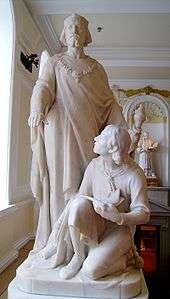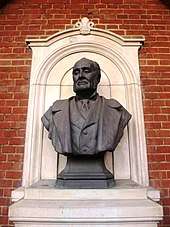F. W. Pomeroy
Frederick William Pomeroy RA (London 1857/58 – 26 May 1924) was a prolific British sculptor of architectural and monumental works. He was one of the so-called New Sculptors identified by Edmund Gosse in 1894 – a group distinguished by a stylistic turn towards naturalism and their work in architectural sculpture.
.jpg)
Early life and training
Pomeroy was born in London, the son of an artist-craftsman. He trained with William Silver Frith at the South London Technical School of Art (formerly Lambeth School of Art and now the City and Guilds of London Art School[1]), where he was also taught by Jules Dalou. In 1880, he was able to enter the Royal Academy Schools, where he won a travelling scholarship; which took him to Paris (where he studied under Antonin Mercié) and Italy. He was elected ARA in 1906, and RA in 1917.
Action in London
On returning to London Pomeroy carved Frederic Leighton's marble group, Athlete wrestling with a python (private collection). In 1887 he joined the Art Workers Guild, and from 1888 he exhibited with the Arts and Crafts Exhibition Society (in 1907 he became master of the Art Workers Guild). He became a leading sculptor in the New Sculpture movement, both in London and elsewhere in Britain. His work in London includes the figure of Justice (1905–1906) on the dome of the Old Bailey (the Central Criminal Court)[2] and the statue of W. E. Gladstone in the Houses of Parliament.
Personal life

In 1913 Pomeroy married Patricia Morrison Coughlan, of Douglas, County Cork. With her he had two sons.[3]
In May 1924 Pomeroy offered a prize "for the most perfect pair of feet"; the actress Daisy Burrell and the dancer Margery Prince tied for the first prize of £50.[4] Pomeroy died on 26 May 1924,[5] aged 65, and was buried at Boscombe in Hampshire. A memorial to him lies in St James's Church, Piccadilly.
Works
Pomeroy's largest outdoor works are the four enormous bronze figures on the upstream side of Vauxhall Bridge in London. Dating from 1907, they represent: Pottery, Engineering, Architecture and Agriculture. Pomeroy's other architectural sculpture includes:
- Sheffield Town Hall
- the figures of Truth, Fortitude and the Recording Angel at the Old Bailey, London
- City Hall, Cardiff
- Paisley Town Hall
- the pediment of Belfast City Hall
- Holy Trinity Church, Sloane Street, London
- extensive work at Liverpool John Moores University
- Statue of Brigadier General John Nicholson, Lisburn
Smaller works include:
- The Spearman bronze statue[6]
- statue of Queen Victoria in Woolwich Town Hall
- bronze statue of Oliver Cromwell in St Ives, Huntingdonshire[7]
- statue of the 16th Earl of Derby in the Concert Hall of St George's Hall, Liverpool[8]
- statue of the Reverend Dr Thomas Guthrie DD in West Princes Street Gardens, Edinburgh
- marble reredos at St Saviour's Church, Colgate, West Sussex[9]
- statue of George Livesey of the Metropolitan Gas Works 1909, Peckham, London Borough of Southwark
- Robert Burns statue at Fountain Gardens, Paisley
- statue of Robert Blake in Bridgwater
- statue of Sir Francis Bacon at Gray’s Inn, London
Gallery
- Pottery on Vauxhall Bridge
 Pomeroy's statue of Oliver Cromwell in St Ives, Huntingdonshire
Pomeroy's statue of Oliver Cromwell in St Ives, Huntingdonshire

 Bust of Sir Clements Robert Markham
Bust of Sir Clements Robert Markham The Lily of Killarney
The Lily of Killarney The Spearman bronze statue
The Spearman bronze statue_-_The_Wood_Nymph_(1908)_front_part_right%2C_Lady_Lever_Art_Gallery%2C_Port_Sunlight%2C_Cheshire%2C_June_2013_(9097771208).png) The Wood Nymph (1908), Lady Lever Art Gallery, Port Sunlight, Cheshire
The Wood Nymph (1908), Lady Lever Art Gallery, Port Sunlight, Cheshire Bishop Ridding Memorial to George Ridding in the choir of Southwell Minster
Bishop Ridding Memorial to George Ridding in the choir of Southwell Minster
References
- City and Guilds of London Art School
- "Justice - Frederick William Pomeroy". Victorian Web. Retrieved 6 November 2019.
- "A Noted English Sculptor. Mr. F. W. Pomeroy, R.A.". Obituaries. The Times. London. 27 May 1924. col E, p. 21.
- The Miami News. 29 May 1924. p. 9 https://news.google.com/newspapers?nid=2206&dat=19240529&id=8G0uAAAAIBAJ&sjid=h9gFAAAAIBAJ&pg=2578,5325222
|url=missing title (help). column 2 - "POMEROY, F. W., RA 1917 (ARA 1906)". Who Was Who 1916–1928. London: A & C Black. 1992. ISBN 0-7136-3143-0. "died 26 May 1924"
- Encyclopædia Britannica, ed. 1911, vol. 24, pg. 505, Plate IV.
- Pevsner, Nikolaus (1968). Bedfordshire and the County of Huntingdon and Peterborough. The Buildings of England. Harmondsworth: Penguin Books. p. 338. ISBN 0-14-0710-34-5.
- Sharples, Joseph; Pollard, Richard. Liverpool F.C.. In Pollard, Richard; Pevsner, Nikolaus (2006). Lancashire: Liverpool and the South-West. The Buildings of England. New Haven and London: Yale University Press. p. 296. ISBN 0-300-10910-5.
- Elleray, D Robert (2004). Sussex Places of Worship. Worthing: Optimus Books. p. 17. ISBN 0-9533132-7-1.
External links

- Online description of Pomeroy's work
- Perseus with the Head of Medusa – bronze statuette in V&A Photo by ketrin1407 on Flickr
- The Nymph of Loch Awe Photo by ketrin1407 on Flickr – one of a set taken at Tate Britain's New Sculpture exhibition in August – September 2010
